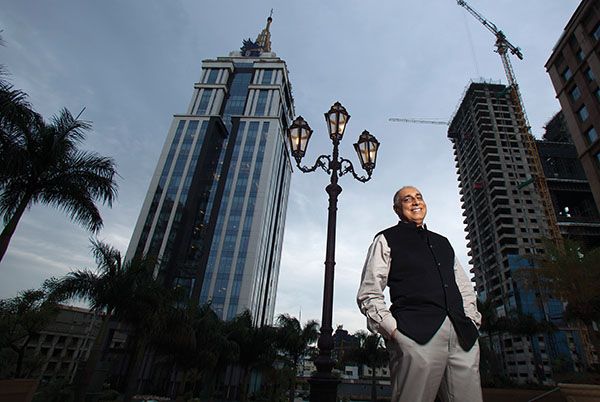As the Pakistani armour reached the vital bridges across the Beas river, it seemed only a matter of time before the tanks broke through Indian defences.
Pakistan had a bold plan to reach the bridges at Harike and Beas which would give it multiple options of threatening Amritsar, Jalandhar and onward to Delhi. It is also apparent that India’s Western Command was not certain of the location of Pakistani 1 Armoured Division, which was positioned at Kasur, ready to spearhead the offensive into India’s critical bridges on the Beas.
D-day for the operation was initially September 7, 1965. Inexplicably, Pakistan delayed the offensive by 24 hours. The delay helped the Indian troops prepare defences, lay mines and undertake flooding of the fields by breaching the Rohi Nala and the distributary canals to make the open area waterlogged. This automatically imposed restrictions on the movement of the Pakistani armour. As the unsuspecting tanks of Pakistan’s 1 Armoured Division launched the offensive at 8.30 am on September 8, they were engaged by tanks of Deccan Horse. Utilising standing crops, the tanks were engaged by Deccan Horse, medium guns and tank-hunting teams. Deccan Horse managed to destroy 11 tanks while losing four of their own. Three other Pakistani tanks were damaged by medium guns and tank-hunting parties.
Such heavy losses compelled the Pakistanis to retreat. Their units launched the next attack after a considerable gap at 11.30 on September 8. The attack was led by a regiment of Pattons, a squadron of Chaffees and a motorised battalion of the Pakistani 4 Armoured Brigade. They attacked 1/9 Gorkha Rifles and 4 Grenadiers. The attack was partially successful in the 1/9 Gorkha Rifles location but unable to make headway in 4 Grenadiers. The Pakistanis again attacked 4 Grenadiers at 12. Despite some of their trenches being overrun, the battalion with its anti-tank gunners comprising Subedar Mool Chand and Company Quarter Master Havildar (CQMH) Abdul Hamid knocked out four tanks. The armour tried to outflank the divisional sector from the north but the prepositioned tanks of 3 Cavalry countered this ably. Attacks were made at dawn on September 9 too along both axes. Two tanks were blown up on the minefield and another was destroyed by the recoilless gun of 4 Grenadiers. During the afternoon, the Pakistanis made an attempt to outflank from the southeast but failed as they got bogged down in the flooded area at Valtoha and were destroyed one by one.
————————————————————————————————-
| On the third day of the op, the Pakistani tanks had overrun the forward trenches. CQMH Abdul Hamid got three, not the fourth. |
—————————————————————————————————
In the battle, some Pakistani tank commanders who had their heads out of the cupola were killed. By September 10, the Pakistanis were in a desperate situation. They tried to outflank the defences from the west with two regiments of Pattons and a squadron of Chaffees with a motorised battalion only to be encountered by the tanks of 3 Cavalry and 8 Cavalry that were camouflaged in the cane fields. Then, 4 Grenadiers was attacked with a battalion of infantry and a few Patton tanks. The tanks managed to overrun the forward trenches. CQMH Hamid who had been shifted to the anti-tank platoon destroyed three tanks but was shot by the fourth. For this act of gallantry, he was awarded the Param Vir Chakra posthumously. As the attack on 4 Grenadiers failed, the Pakistani outflanking armour charged on Mahmudpura, but they were decimated by the Centurions lying in wait, crushing Pakistan’s 1 Armoured Division. The commanding officer of Pakistan’s 4 Cavalry was captured in the cane fields. Asal Uttar-Khem Karan was a great victory for the Indian army. The Pakistanis lost 97 tanks, including 72 Pattons; 32 were captured in running condition. India in contrast lost only five. India won what is now acknowledged as the biggest tank battle fought after WW-II.
It is now apparent that Pakistan had grand plans but poor execution. India on the other hand displayed keen tactical sense, resolute leadership and clever improvisation to turn the tide of the war. The battle also showed that the man behind the weapon is more important than the weapon itself. Deccan Horse and regiments of 2 Independent Armoured Brigade were adept at handling Shermans, Centurions and AMX tanks. In assaults led by armour, the infantry must move with the armour. This prevents tanks falling prey to anti-tank weapons, something CQMH Hamid exploited.
Demoralised with the setback at Khem Karan, Pakistan lost the heart to fight. Today, a memorial for those who fought and won in this sector boasts a board ‘Patton Wreckers’ on the general area of Assal Uttar and Khem Karan. It’s a reminder that no matter how good the weapon, the battle is won by those who wield it effectively.
(Former Outlook staffer Nitin Gokhale is a defence analyst. He is currently writing a book on the ’65 war.)
source: http://www.outlookindia.com / Outlook / Home> International – Opinion / by Nitin A. Gokhale / Magazine – May 25th, 2015

















